|
 Suillus granulatus Suillus granulatus
SynonymsBoletus granulatus
BiostatusPresent in region - Exotic
Images (click to enlarge)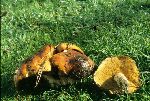
Owner: Barbara Segedin | 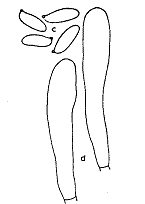
Caption: S. granulatus: c, spores; d, cystidia. e, f. | 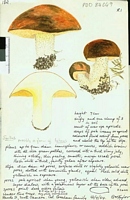
Caption: Watercolour
Owner: G.M. Taylor | 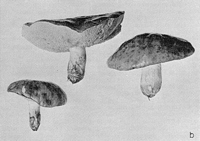
Caption: Fig. 4 - b, Suillus granulatus (x 1/2) | 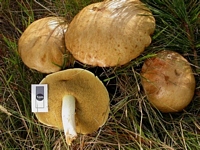
Owner: J.A. Cooper | 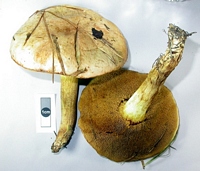
Owner: J.A. Cooper | 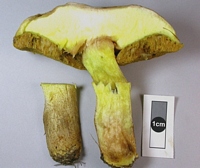
Owner: J.A. Cooper |
Article: Stevenson, G. (1962) [1961]. The Agaricales of New Zealand: I. Kew Bulletin 15(3): 381–385.
Description: Pileus 7-10 cm, diam., glutinous at first, ochraceous to light red-brown, drying sub fibrillose, pellicle peeling; flesh white to pale yellow, scarcely turning colour when cut. Pores up to 1 mm. diam., readily separable, yellow at first, darkening to ochre, depressed round stipe or almost sinuately decurrent. Stipe 1.5-2 X 3-8 cm., without a ring, equal or tapering to the base, yellow above, becoming fawn or brown below, finely dotted with darker glandulae, Spores 10 X 3-3.5um, thick-walled.
Habitat: associated with Pinus at Hanmer, Nelson and elsewhere.
Article: McNabb, R.F.R. (1968). The Boletaceae of New Zealand. New Zealand Journal of Botany 6(2): 137-176 (http://www.rsnz.org/publish/abstracts.php).
Description: PILEUS: convex to plano-convex. 5-13-(16) cm diam.,
mucilaginous, glabrous, buff yellow, tan, reddish tan or orange cinnamon, occasionally
dull reddish brown; cuticle an ixotrichodermium, readily separable; margin entire,
often incurved and extending beyond pores when young. HYMENOPHORE: tubes 7-13
mm long, adnate to subdecurrent, pallid creamy white when young, becoming yellow
to sordid yellow at maturity; pores concolorous with tubes, becoming spotted
dark reddish brown at maturity, angular to radially elongated. 0.5-1 mm diam.,
beaded with droplets of cloudy, white liquid when young. STIPE: 4.5-8 cm long,
more or less equal, 1-2.5 cm diam., solid, white to creamy white at first, becoming
bright yellow apically, sordid brownish below; glandulae numerous, pinkish brown
to reddish brown; flesh white at first, becoming yellow with age; annulus absent.
SPORES: spore print yellowish brown (between Cinnamon
and Pinkish-Cinnamon); spores pallid melleous, elliptic-subfusiform, 7.1-9.3-(10.6)
X 2.8-3.1-(3.4) µm., smooth. HYMENIUM: basidia hyaline, clavate, 19-26 X 5.5-8
µm. 4-spored; cystidia scattered or crowded in groups at or near tube mouths,
hyaline or encrusted with brown, resinous material, cylindrical to clavate,
33-45 X 6.5-10 µm. HYMENOPHORAL TRAMA: bilateral, of the Boletus subtype; clamp
connections absent. CONTEXT OF PILEUS: white when young, becoming pallid yellow
at maturity often with watery greenish yellow line immediately above tubes,
unchanging on exposure to air. TASTE: mild. SMELL: not distinctive. CHEMICAL
REACTIONS: KOH on pileus— greyish brown; on context of pileus—immediate red
flush turning lilac; NH4OH on pileus—slowly darkening; on context—immediate
red flush turning lilac.
Habitat: HABITAT: Gregarious or caespitose under Pinus.
Notes: Suillus granulatus is an introduced species associated with Pinus in the temperate
zone of the northern hemisphere and is widely distributed in both Europe and
North America. The relatively large degree of variability encountered in Suillus
granulatus over its natural geographical range has resulted in the recognition
of a large number of infraspecific taxa. Of the more recent attempts to divide
the species the most comprehensive treatments are those of Singer (1945a) and
Blum (1965).
Singer distinguished
four subspecies on the basis of minor differences in spore size, small differences
in colour of the fruitbodies, geographical distribution, and mycorrhizal associations
in nature. The results of applying this classification to New Zealand specimens
are inconclusive, for many collections possess spore and colour characters intermediate
between two subspecies. However, it should be noted that Singer's classification
arose from observations on specimens growing in their indigenous habitats. It
is possible that under New Zealand conditions, where both fungus and mycorrhizal
partner have been introduced, a degree of morphological modification of Suillus
granulatus has occurred, with the result that subspecific differences are
no longer distinct. The high degree of taxonomic significance attached to mycorrhizal
associations of the subspecies by Singer (1945a) is not supported by field observations
in New Zealand. No constant differences could be found between specimens growing
under Pinus strobus and P. pinaster, although according to Singer
these specimens should belong to Suillus granulatus ssp. snellii Singer
and ssp. leptopus (Pers.) Singer respectively.
Blum (1965) recognised
five varieties of S. granulatus based primarily on spore size and colour
differences in the fruitbodies. As with Singer's scheme, it is not possible
to place New Zealand specimens with any degree of certainty using this classification.
In view of the
difficulties in assigning them to any of the described subspecific taxa, New
Zealand collections are simply referred to the species. Smith and Thiers (1964)
also encountered difficulty in defining S. granulatus ssp. snellii,
the subspecies restricted to North America, and relegated it to the excluded
species. Smith and Thiers (1966) later concluded that a number of variants of
S. granulatus existed, in which small variations in spore size were apparently
correlated with certain groups of the genus Pinus. Four variants were
distinguished on this basis but because of the small differences involved, it
was considered not worth naming them.
Suillus granulatus is an excellent edible fungus but
as with most Suilli, the mucilaginous pellicle of the pileus should first be
removed,
S. granulatus
may be recognised by the buff yellow, tan, or reddish tan pileus, presence of
glandulae on the stipe, and absence of an annulus. Which was first recorded
from New Zealand by Walker (1931).
Article: Gadgil, P.D. (in association with Dick, M.A.; Hood, I.A.; Pennycook, S.R.) (2005). Fungi on trees and shrubs in New Zealand. Fungi of New Zealand. Ngā Harore o Aotearoa 4: xi + 437 p. Hong Kong: Fungal Diversity Press.
Description: Type: Mycorrhizal Fungi; Description: Basidiomata pileate. Pileus buff yellow, reddish tan to cinnamon orange, 50–150 mm in diameter, convex to plano-convex, mucilaginous; flesh yellowish with a greenish yellow line immediately above the tubes. Pore surface adnate to subdecurrent; tubes creamy white becoming yellow, 7–13 mm long; pores concolorous with tubes, becoming spotted reddish brown, angular, 0.5–1 mm in diameter. Stipe more or less cylindrical, white at first, becoming bright yellow towards the apex and dirty brown below, speckled with numerous pinkish brown to reddish brown glandulae, annulus absent, 45–80 mm long. Basidiospores elliptical, 0-septate, 7–10 × 3–4 μm, smooth, yellowish.
DISTRIBUTION: Northland, Auckland, Coromandel, Waikato, Bay of Plenty, Taupo, Wanganui, Gisborne, Hawkes Bay, Nelson, Buller, Westland, Marlborough, North Canterbury, Mid Canterbury, South Canterbury, Dunedin, Southland, Chatham Islands.
Distribution: Distribution: Northland, Auckland, Coromandel, Waikato, Bay of Plenty, Taupo, Wanganui, Gisborne, Hawkes Bay, Nelson, Buller, Westland, Marlborough, North Canterbury, Mid Canterbury, South Canterbury, Dunedin, Southland, Chatham Islands.; 1st Record: McNabb (1968).
|